IoT in Smart Cities: Revolutionizing Urban Living with Smart Cities Technology
Key Topics Covered
-
How Does IoT Reduce Traffic Congestion?
IoT improves urban mobility through real-time traffic monitoring, adaptive traffic lights, and predictive maintenance for public transit systems. -
How IoT Creates Sustainable Energy Solutions?
Smart grids, renewable energy integration, and IoT-enabled devices optimize energy distribution and reduce waste in growing cities. -
How Does IoT Enhance Public Safety in Smart Cities?
IoT-enabled surveillance, disaster management systems, and connected infrastructure improve urban security and emergency response. -
How IoT Revolutionizes Waste Management?
IoT-connected smart bins and optimized collection routes reduce costs, improve recycling, and promote sustainability. -
What Are the Challenges and Solutions for IoT in Smart Cities?
Overcoming privacy concerns, infrastructure costs, and interoperability issues ensures successful IoT integration for urban development.
Smart Traffic Management
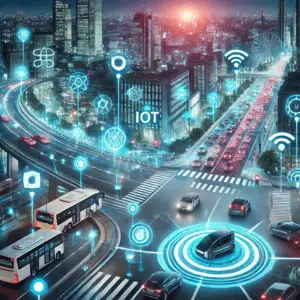
You’ve probably seen it — or maybe you’ve heard someone talk about it — cities trying everything they can to deal with traffic. Picture this: an intersection lit up with neon signs, and traffic lights that don’t just change because some timer tells them to.
Instead, they’re paying attention to what’s happening around them. And those little sensors? They’re quietly doing their job, keeping tabs on how cars, bikes, and people are moving so things don’t get clogged up. And there are sensors everywhere — keeping an eye on the flow, trying to keep things from turning into gridlock. It sounds futuristic, but it’s already happening in more places than you might realize.
Let’s face it — traffic’s a nightmare in most cities. It eats up time, costs billions in lost work hours, and adds way too much pollution to the air. That’s where IoT (Internet of Things) is stepping in. Cities are using it to give their traffic systems a much-needed upgrade so they can keep up with how packed the roads have gotten.
Here’s the basic idea: you’ve got cameras, sensors, and devices everywhere — at lights, in the streets, even in crosswalks — all sharing info in real time. The systems are keeping tabs on:
- Traffic flow: How cars are moving through busy intersections
- Vehicle density: Where traffic’s backing up, especially during those brutal rush hours
- Pedestrian activity: Where people are crossing so everyone stays safe
And because they’ve got this info as it happens, cities can adjust lights and signals on the fly. That means less sitting in traffic, shorter commutes, and hopefully, cleaner air too.
Global Examples of IoT in Traffic Systems
-
Los Angeles Advanced Traffic Management System (ATMS):
- Monitors over 4,500 traffic signals in real-time.
- Achieved a 12% reduction in citywide travel times.
- Helps reduce greenhouse gas emissions by minimizing vehicle idling.
-
Singapore’s Smart Traffic Control:
- Utilizes IoT cameras and adaptive traffic signals to optimize traffic flow.
- Reduced idling times and greenhouse gas emissions significantly.
-
Barcelona, Spain:
- Employs IoT-enabled traffic systems to integrate with public transportation.
- Improved commute times by offering predictive transit schedules via mobile platforms.
-
Tokyo, Japan:
- Combines IoT with AI to analyze traffic patterns and predict peak congestion.
- Reduces bottlenecks using proactive traffic rerouting.
Challenges in Implementing IoT in Traffic Management
While the benefits are substantial, cities face several hurdles when adopting smart city technology:
- High Initial Costs: Deploying IoT sensors, cameras, and infrastructure requires significant investment, which can be challenging for smaller cities.
- Data Privacy Concerns: IoT systems generate massive amounts of sensitive data. Robust cybersecurity measures and compliance with data regulations like GDPR are crucial.
- Interoperability Issues: Ensuring seamless communication among devices from different manufacturers remains a challenge.
Cities are addressing these challenges through public-private partnerships and modular solutions that allow gradual scaling of IoT infrastructure.
Public Transportation and Predictive Maintenance
Public transportation systems have embraced IoT integration to enhance commuter experiences:
- Real-Time Tracking: IoT-enabled systems provide accurate arrival times for buses, trains, and ride-sharing vehicles. Cities like London and New York offer live updates through mobile apps, streamlining journey planning.
- Predictive Maintenance: Sensors continuously monitor key components like brakes and engines, reducing downtime and ensuring passenger safety.
Learn more about how mobile app development integrates with IoT to improve urban mobility.
The Future: Autonomous Vehicles and V2X Communication
The integration of autonomous vehicles and vehicle-to-everything (V2X) communication with IoT represents the next frontier in traffic management. Real-time data exchange between vehicles, infrastructure, and pedestrians will:
- Enhance road safety by reducing accidents.
- Optimize traffic flow in increasingly populated urban areas.
Discover how predictive analytics in eCommerce parallels IoT advancements in transportation.
As urban populations continue to grow, IoT in smart cities will remain critical for creating sustainable, efficient, and safe transportation networks.
Energy Efficiency and Sustainability
Let’s be real — cities burn through energy like crazy, and with more people moving in, it’s only getting harder to manage. That’s where IoT is stepping in, helping cities get smarter about how they use (and save) energy.
Key Innovations in Energy Efficiency
-
Smart Grids? These are like having sensors scattered all over the place, watching how much power people are using at any moment. When everyone’s cranking their AC during a heatwave? The system can shift things around so the grid doesn’t crash. It’s like having a traffic cop for electricity.
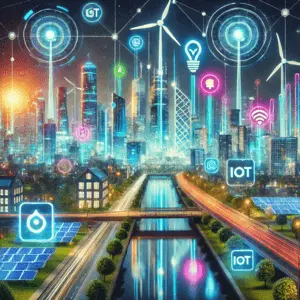
- Renewable Energy?Places like Amsterdam are using IoT to juggle solar and wind so it all works together without a hitch. When the sun’s out — great. When the wind kicks up — no problem. It all flows into the system without someone having to manually switch things over.
- Smart meters? These little devices show folks how much power they’re actually using — right then, not on some bill a month later. Helps people see where they can cut back and maybe save some cash too.
What This Looks Like in the Real World Here’s what cities are actually doing:
- Amsterdam: Their grid adjusts in real-time to avoid wasting energy. Solar, wind, you name it — it all blends together.
- Barcelona: Their streetlights aren’t blasting at full power all night. They dim when nobody’s around, and it’s saved them a ton of money.
- Big buildings (think offices, hotels): They’ve got systems that predict when they’ll need more or less heating or cooling. No more running the AC on high when the building’s empty.
- Tokyo: Their grid stays balanced even when demand spikes, and they’re mixing in renewables too without breaking a sweat.
- San Diego: Their smart lights dim during slow hours, saving energy without leaving streets dark.
The Challenges (Because Nothing’s Ever Easy)
Sure, IoT is awesome — but it’s not magic. There are some headaches cities have to deal with:
- Big price tag at the start. Getting the gear installed — sensors, grids, systems — costs a lot. Smaller cities especially feel the pinch.
- Data privacy. All this tech collects tons of info. If that data isn’t locked down, it’s a problem. Cities have to make sure they’re keeping info safe and following privacy rules like GDPR so people don’t freak out.
- Getting everything to work together. Different companies make different parts, and they don’t always play nice. Open standards help — but getting there takes work.
Most places are teaming up with private companies to spread out the costs. And a lot of them are building things bit by bit instead of trying to do it all at once.
Big Picture
At the end of the day, IoT is helping cities clean up their act — less waste, smarter systems, better for the planet. And when you throw AI into the mix? We’re talking about a whole new level of efficiency that’s only going to keep improving.
Public Safety and Security
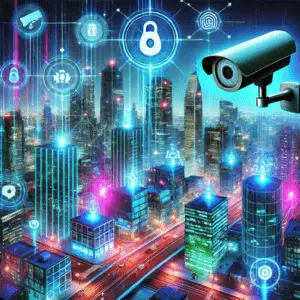
(A high-tech surveillance camera watching over a neon-lit city — IoT in action, keeping public spaces safer.)
Let’s face it — keeping people safe is one of the biggest jobs any city has. And as cities get bigger and busier, that job gets tougher. That’s where IoT (Internet of Things) steps in. This tech is giving cities better ways to keep an eye on things, spot trouble early, and act fast when something’s wrong.
Take those smart surveillance systems you’ve probably heard about. These aren’t just your old-school security cameras. They’ve got facial recognition, motion sensors, and even audio detection — all working around the clock. In places like Singapore, these cameras are everywhere, helping police spot things like large crowds forming or someone sneaking into a restricted area. And the best part? They send alerts instantly, so officers can step in before a small issue turns into a big one.
It’s not just cameras, either. First responders like firefighters and paramedics are using IoT gear that helps keep them safe while they help others. Firefighters, for example, are wearing smart helmets that check for toxic gases, track temperature, and keep tabs on air quality. That info gets sent straight to command centers, so teams can make safer, faster decisions. Paramedics? They’ve got wearables that monitor their vitals during intense situations — a big help when every second counts.
And have you noticed those streetlights that seem smarter these days? In cities like Chicago and Barcelona, IoT-equipped streetlights can pick up on strange noises or weird movement. If something seems off, they brighten up the area, record what’s going on, and ping the local authorities.
When it comes to natural disasters, IoT’s making a huge difference too. Early warning systems use sensors to track earthquakes, rising rivers, or dangerous weather. In Japan, for instance, coastal sensors help spot tsunami risks early, giving folks and emergency teams a chance to act before it’s too late.
IoT's even helping with public health. Cities are using air quality sensors to watch pollution levels — when things get bad, they can alert people and take action fast. Same goes for water quality. If something’s wrong with the drinking water, IoT sensors pick it up and let the right people know.
Now, add AI to the mix, and things get even smarter. AI looks at all that data from IoT devices, finds patterns, and helps predict where problems might pop up — like which neighborhoods might see more crime. That way, cities can put resources where they’re needed before trouble starts.
Of course, all this tech means cities have to handle a lot of sensitive info — and that’s where things get tricky. Cybersecurity is a must. Cities need to lock down data with strong encryption and follow strict privacy rules so people can trust the system.
Bottom line? IoT is changing how cities keep us safe — from smarter surveillance and faster emergency response to cleaner air and water. As more cities blend IoT with AI and mobile tech, we’ll see even safer, smarter, and more connected communities.
Smart Waste Management
(Picture smart bins scattered through city streets, quietly working to make sure waste is handled better — and cleaner.)
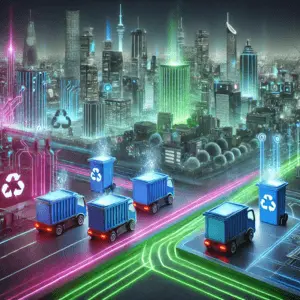
Let’s be honest — traditional trash collection just doesn’t cut it anymore. Trucks drive the same routes at the same times, no matter if the bins are overflowing or nearly empty. That means trucks burning up fuel for no good reason, more costs piling up for the city, and extra pollution hanging in the air. And let’s not forget — missed pickups drive people nuts. No one wants to see overflowing trash on their street.
That’s where IoT steps in and changes the game. Cities are starting to use smart bins with sensors that can tell how full they are and even what kind of waste is inside. These bins send real-time updates so crews know exactly where to go and when. The difference? It’s big. Look at Copenhagen — they’ve managed to cut out about half of those unnecessary collection trips. That means fewer trucks on the road, cleaner air, and money saved.
Stockholm’s doing something similar. The city’s got thousands of smart bins that keep an eye on how much trash they’re holding. When one’s almost full, it pings the team so they can empty it before it turns into a mess. This setup hasn’t just helped keep the streets looking better — it’s knocked down collection costs by about 40%. Good for the environment, good for the budget.
IoT is also making recycling smarter. Some bins come with tech that can spot and sort recyclables — paper, plastic, metal — right on the spot. Others can flag hazardous waste before it ends up where it shouldn’t. This kind of sorting helps keep recyclables clean and usable, so less of it ends up in landfills.
And it’s not just the city doing this. Private businesses, apartment complexes, and industrial sites are using smart compactors that crush down the trash to fit more in. That means fewer pickups needed — and with detailed data from these systems, businesses can see how much waste they’re creating and find ways to cut back.
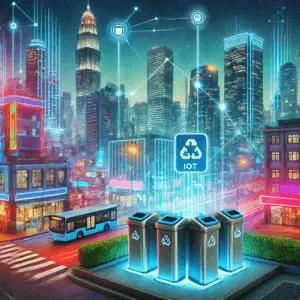
What’s really cool is how all that data feeds into bigger city plans. With accurate info on waste patterns, cities can design better recycling programs, target problem areas, and promote greener habits through public campaigns.
Sure, rolling out these systems isn’t cheap. Cities need to invest in the bins, the tech, and the platforms that keep it all connected. That’s where public-private partnerships come in, helping share the load. And with so much data flying around, keeping it secure is key to keeping the public’s trust.
Bottom line: IoT is giving cities the tools to clean up waste management — making it faster, smarter, and better for the planet. Want to see how IoT is making waves in other industries? Take a look at our IoT applications across industries.
Challenges and Solutions
(Picture a glowing city filled with smart tech — but behind those neon lights are some pretty big hurdles to tackle.)
Sure, IoT has a lot to offer when it comes to building smarter cities. But let’s not sugarcoat it — rolling it out comes with its fair share of challenges. One of the biggest? Data privacy and security. These systems collect a ton of sensitive information — not just about traffic or air quality, but about people, places, and daily operations. If that data isn’t locked down tight, it’s at risk. Breaches can mean misuse, exploitation, or worse.
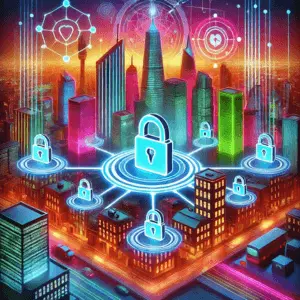
That’s why cities have to put cybersecurity front and center. We’re talking end-to-end encryption, secure device logins, and making sure everything meets tough standards like GDPR. And it’s not just about tech — cities need to be upfront with people about how data’s being used. When folks understand what’s happening with their info, they’re way more likely to support these smart city projects.
Then there’s the cost. Setting up all this IoT infrastructure — the devices, networks, systems to run it — doesn’t come cheap. And keeping it updated? Also pricey. That can be a big problem for smaller cities trying to stay competitive. One way around it? Public-private partnerships. By teaming up with tech companies, cities can share the costs and get expert help. Many are also going modular — building out IoT systems bit by bit so the costs are spread out over time rather than hitting all at once.
Another headache is getting all these devices to play nice together. With so many manufacturers and platforms out there, making sure everything connects smoothly can be tough. The solution? Open standards. When cities push for shared protocols, it helps vendors work together — which keeps things running smoothly and saves money in the long run.
And let’s not forget about tech burnout. IoT gadgets and systems evolve fast. If cities don’t keep up, outdated tech can drag down performance and jack up maintenance costs. The key is investing in gear that’s built to scale and adapt — and doing regular checkups on the system so nothing falls behind.
Finally, public trust can make or break these projects. People worry about privacy, surveillance, and how the tech might be used down the line. Cities that want buy-in need to bring residents into the conversation. Town halls, forums, even online surveys — giving people a voice helps build support and keeps projects on track.
At the end of the day, yeah — IoT comes with challenges. But the upside is huge. With smart planning, strong security, and a little help from AI-powered tools, cities can turn these hurdles into opportunities. Predictive maintenance, better decision-making, and faster responses all help create places that are cleaner, safer, and easier to live in.
Curious how IoT is changing other industries? Check out our IoT applications across industries for more on what’s ahead.

Partner with an AI Content Creator & SEO Specialist
If you’re seeking a detail-oriented professional who combines creativity, data-driven strategy, and technical skill to deliver exceptional digital content—your search ends here.
My name is Genny Allison, and through Allison Stock Inc., I specialize in AI-powered content creation and SEO-focused website development. Using advanced tools such as ChatGPT, MidJourney, Figma, and Uizard, I craft optimized content and designs that align with both search engine standards and user experience expectations.
My portfolio showcases how I blend innovation with strategy to create high-performing, visually engaging, and accessible websites. Each project reflects a deep understanding of SEO best practices, AI-assisted workflows, and the importance of performance, responsiveness, and clarity in modern web design.
Connect with me on LinkedIn , explore my portfolio , or visit my contact page to see how I can help bring your vision to life.





